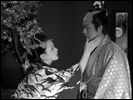Sakuran
- Year
- 2007
- Original title
- Sakuran
- Japanese title
- さくらん
- Director
- Cast
- Running time
- 111 minutes
- Published
- 22 March 2007



by Tom Mes
More and more often, directors complain that there is no longer any room for original ideas in Japanese filmmaking. The industry is playing it safe with adaptations of popular novels or manga, while those looking to find funding for their original screenplays are politely shown the door.
However, as has long been the case, the talent that is willing to accept the industry's basic restrictions will often find a surprising amount of elbowroom. All it takes is enough imagination to realize that if the terrain is strictly demarcated, the solution is to look up and build high rather than wide. Although in all fairness it must be noted that producers increasingly prefer someone at the helm who sticks rigidly to the blueprints, with no surprises, especially now that production budgets are increasing - this is something of a Golden Age, but only if you're a TV director looking for a big screen outing.
At first glance, Sakuran hardly looks like it's going to break the mould. Not only is it a manga adaptation, it also quite obvious derives its inspiration from two other films. A look at the poster image of Anna Tsuchiya defiantly staring at us in full geisha garb is enough to know that this is the Kamikaze Girls reworking of Memoirs of a Geisha, with a bit of Marie-Antoinette thrown in for good measure. And indeed the film itself fully conforms to expectation: there are plenty of fights in the lavishly decorated henhouse, but here the courtesans are riot girls who have no qualms about kicking each other through the fusuma screen. Sakuran is tailor-made to suit Tsuchiya's bad girl image, and the actress is allowed all the room she needs to totally inhabit her character Kiyohada, who she plays as an Edo-era equivalent to the Kamikaze Girl yanki that was her breakthrough: she snarls, yells and curses in a country hick accent with lots of rolling r's. Tsuchiya's mixed-race features which are such a key factor in her success are all the more conspicuous in full period dress, which is of course the point, for the character as well as the actress's career.
Thankfully, there is more to Sakuran than meets the eye. With a script by Yuki Tanada, who more than made a name for herself with the excellent comedy of changing mores Moon and Cherry - an entirely credible portrait of a young woman in control of her life - and very classy direction from debutante Mika Ninagawa (in daily life a photographer and the daughter of stage - and sometimes screen - director Yukio), Sakuran easily outgrows its limitations and the marketing-led minds of its producers. At this level of production, it is rare that director, writer, and star are all women, but the decision has helped elevate this film quite a few notches above flashy live manga, even though it is undeniably flashy and very, very lively. Ninagawa creates an opulently colourful Yoshiwara, dominated by reds and golds, in which iridescent dragons snake life-size across geisha house walls and the girls' kimonos vie for day-glo glory. The pop-contemporary streak that characterises Ninagawa's photographic work runs through the film as well, with a carefully mismatched soundtrack (hello, Sophia!) of rock, tango and big band tunes (composed by Ringo Shiina), a string of famous cameos (including rocker Kiyoshiro Imawano, director Sabu, and anime mastermind Hideaki Anno, whose wife Moyoco Anno created the original manga), plus a casting that is several diets removed from the moon-faced protagonists that were yesteryear's idea of courtesan beauty (see Yoshie Mizutani in Tomu Uchida's 1959 film Yoshiwara, The Pleasure Quarter / Hana no Yoshiwara Hyakunin-giri for an example).
Tanada's script lends weight to the director's cheeky anachronisms, drawing parallels between the idol star system of today and the scales of popularity of the Yoshiwara three centuries before: once she has attained the supreme status of oiran, Kiyohada's ukiyo-e portraits sell by the caseload to hotblooded men, but the young lady herself soon realizes that without the thrill of ambition and competition, life at the top isn't all it was cracked up to be. In a similar manner, the screenwriter finds playful but no less resounding ways to express the conditions and trappings of life in the brothels - for that is exactly what Sakuran shows it to be. Behind the façade of grace and sophistication, the girls are portrayed as the country bumpkins they are, whose manners are the result of rigorous training. The goal of it all is sex and money, and once the courting and seduction are out of the way, all the decorum and excess ballast go overboard to reveal the bare (in every sense of the word) essences of the characters. And like the symbolic goldfish that regularly float across the screen, gracious, shiny, and wiggling their lush tails, in the end these girls, for al their popularity and status, are merely trapped and on display - gorgeous prisoners inside the bowl, but helpless and doomed outside it.